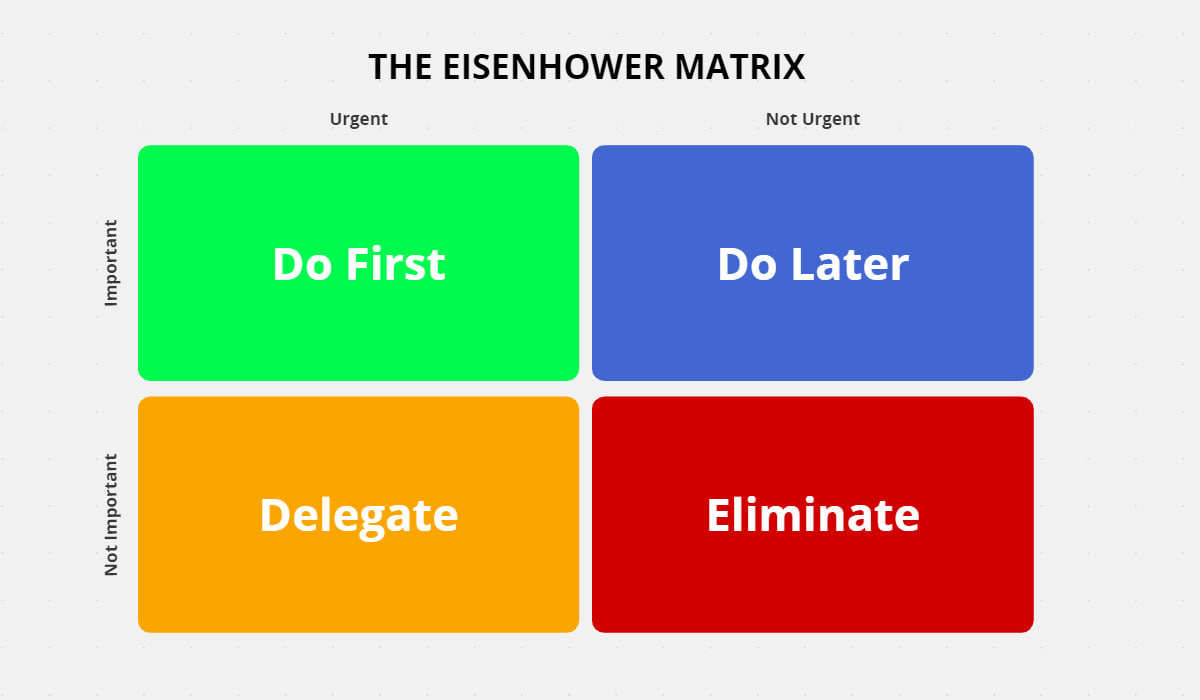What is the Eisenhower Matrix? Its Elements and Steps to Benefit from It -Part I
Former US President Dwight D. Eisenhower said: “No human being on earth can accurately determine the difference between the short term and the long term, especially in times of crisis that force people to focus their full attention on urgent issues rather than planning for important future issues.”
Eisenhower held the rank of general in the army during World War II, served as President of the United States of America, and was known for his high productivity.
During his two consecutive terms in office, Eisenhower succeeded in overseeing the construction of interstate highways, launching the American space agency NASA, enacting the Civil Rights Act, ending the Korean War, annexing the territories of Hawaii and Alaska to the United States of America, and preventing the escalation of the conflict with Russia.
Gallup awarded him the title of Most Popular Person of the Year more than 12 times.
Eisenhower accomplished many things that impacted his country and the world by recognizing the fundamental difference between importance and urgency. In a 1954 speech, Eisenhower quoted an unnamed college professor who said, "There are two kinds of problems: urgent and important. Urgent problems are unimportant, and important problems can never be urgent.
Author Stephen Covey formulated Eisenhower's ideas in his book The 7 Habits of Highly Effective People. The book provides a simple tool for prioritizing tasks, now known as the Eisenhower Matrix, the Time Management Matrix, the Eisenhower Box, the Eisenhower Method, or the Urgent-Important Matrix. This method helps overcome the "urgency effect," eliminates time wasters, and frees up more mental capacity to make progress on goals.
Eisenhower Matrix Formula
The Eisenhower Matrix is used to solve the following problems:
- Constant preoccupation with solving urgent problems.
- Preoccupation with work without achieving actual results on the ground.
- Lack of time and energy needed to make progress on long-term goals.
- Difficulty delegating tasks and refusing requests.
- Difficulty taking on a prestigious position you aspire to.
The article consists of two parts and aims to clarify the difference between urgent and important, how the Eisenhower Matrix can be used to achieve this goal, and the mechanism for applying it to long-term projects and daily tasks.
Difficulty prioritizing tasks
A recent study in the journal Consumer Research examined the method used when comparing tasks that vary in urgency and importance.
After conducting five separate experiments, the researchers concluded that individuals tend to focus their attention more on urgent tasks with a specific and close deadline than on others, even if non-urgent tasks provide better results in the long run.
This tendency is called the “urgency effect” and explains people's difficulty managing time and tasks. People naturally tend to prioritize urgent tasks over tasks that do not require a specific deadline, regardless of the long-term results.
This tendency is particularly prevalent among individuals who always consider themselves busy. The aforementioned research revealed that these people prefer urgent tasks even if their benefits are small because they focus only on the task’s duration factor.
This condition is common among people who suffer from time pressure, which prompts them to prioritize tasks that must be completed according to a specific time plan.
Fortunately, the urgency effect can be overcome, according to the results of the aforementioned study.
The researchers asked participants to think carefully about the consequences of their choices before making a final decision, which increased the likelihood of preferring the important task over its urgent counterpart.
The study recommends considering the importance of non-urgent tasks in the long term to reduce the tendency to prefer urgent matters and focus on important tasks in the long term.
Eisenhower Matrix
The Eisenhower Matrix is a simple tool that considers the long-term results of daily tasks and focuses on increasing work efficiency and productivity. It helps to arrange all tasks within a matrix divided into 4 quadrants based on the factors of importance and urgency. The matrix classifies all daily tasks and large projects into the following categories:
- Important and urgent tasks and projects: Work on them immediately.
- Important and non-urgent tasks and projects: Postpone them to a later date.
- Urgent and non-important tasks and projects: Delegate them to someone else.
- Non-urgent and non-important tasks and projects: Remove them from the to-do list.
Distinguishing between urgent and non-urgent and between important and unimportant in practical life is much more difficult than within scientific experiments and research. The author Covey explains these differences as follows:
Urgent tasks:
These tasks require immediate intervention and cannot be postponed, and failure to complete them often has dire and clear consequences. Urgent tasks cannot be avoided, but people are exposed to high-stress levels and burnout when they spend most of their time dealing with urgent matters.

Important tasks
These tasks contribute to achieving long-term goals and commitment to life values, and they require extensive planning and thoughtful application.
Focusing on important matters helps manage time, energy, and attention and avoid wasting and dispersing these resources unconsidered. Importance depends on personal values and goals, and it varies from one person to another, and no one can estimate the standard of importance for you:
The Eisenhower Matrix consists of 4 quadrants as follows:
1. Quadrant One: Important and Urgent
Urgent and important tasks require immediate implementation, and they often require a specific deadline for delivery, and postponing them has dire consequences. These tasks are often imposed on people suddenly, or they have continued to postpone them for a long time, and their deadline has become close. Examples of them are mentioned as follows:
- Completing a colleague's work who had to be absent from work due to a health crisis.
- Car breakdown on the road.
- Unsustainable household problems, such as a leaky sewer system.
- A client has an urgent problem that requires your help.
- An imminent deadline.
You are bound to encounter these types of tasks no matter how keen you are to perform the tasks required of you on time and do not tend to procrastinate because they are often beyond your control and related to the circumstances surrounding you. The problem arises when an individual focuses on urgent and unexpected matters at the expense of important long-term goals.
Covey confirms that spending too much time on Quadrant I tasks increases psychological stress, job burnout, and a feeling of losing control over daily life. Continuous work on urgent tasks can drain energy and passion for work.
2. Quadrant Two: Important and Non-Urgent
Quadrant two includes tasks and activities that help achieve long-term goals, and they often do not have a specific deadline, which often prompts the individual to postpone them at the expense of urgent tasks. These tasks affect the effectiveness of achieving goals in the long term. Some examples include:
- Planning long- and short-term projects.
- Routine work and maintenance projects.
- Building professional and personal relationships.
- Acquiring new skills, following up on ongoing research in the field of work, and attending educational events.
- Exercising and routine self-care practices.
Covey confirms that Quadrant Two is ideal for managing time, investing in available opportunities, and pursuing personal and professional development instead of focusing on solving urgent problems, as in Quadrant One.
Commitment to Quadrant Two tasks means that people are active and proactive in planning for the future, prioritizing activities that help them develop their skills and abilities, renew their energy, and achieve their goals.
Focusing on Quadrant Two tasks reduces the number of urgent problems that arise in Quadrant One and prepares the necessary action plans to achieve goals and complete future projects.
In conclusion
People often get caught up in the emergencies of daily life and are forced to prioritize them over their personal goals and ambitions. The Eisenhower Matrix is used to overcome this problem by classifying tasks based on urgency and importance.
The first part of the article provides comprehensive information about the Eisenhower Matrix. It explains the nature of the tasks belonging to the first two quadrants. The second part examines the remaining two quadrants.


 Main menu
Main menu





